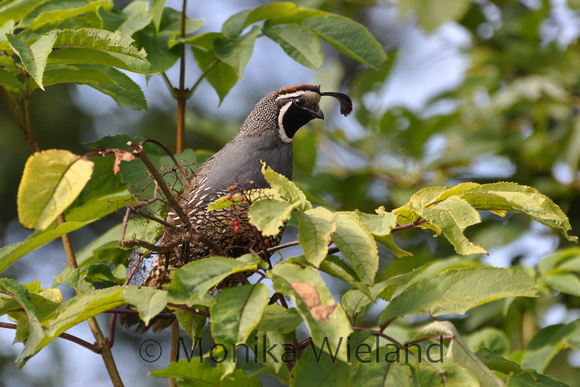With 2020 in no way shaping up as planned, with two cancelled vacations we found
ourselves ready for a little getaway after more than 6 months without leaving
San Juan Island. Only interested in visiting unpopulated areas, wanting to see
some new birds, but also to stay in the state of Washington, we decided to head
due east from home, east of the Cascades into Okanogan County. While we had
explored the Winthrop/Twisp area before, this time we decided to go further
east, renting a home-base cabin 30 minutes east of Tonasket out in the woods.
It didn't take long to start seeing new bird species to add to our photo year list; the most exciting one on the way to our cabin was a flock of mountain bluebirds.
While the goal of the trip was birding, the all-around change of scenery is much appreciated, including the vegetation. It's amazing how different the plant life can be just a few hours drive from home. I could spend all day looking at the trees and shrubs and trying to identify them - in fact we did spend an hour on one quarter-mile trail just looking at the plants! We've timed it well for the fall colors, too, which as been an added bonus.
Our plan has been a series of loop drives from our home base cabin, exploring all kinds of back roads in search of wildlife. The weather has been better than expected - in fact, hotter than expected, and we did not pack accordingly! But no complaints about the all-day sunshine and the amazing photographic opportunities that has helped provide.
 |
| Black-billed magpie in perfect light |
One of the biggest surprises of the trip was finding a black bear! While we had visited suitable bear habitat, where we saw it was not at all where I would picture a bear - in the middle of farm country. I'm glad I got a photo before it disappeared over the hill, or I might not have believed I really saw it!
The mammal diversity has been better than expected as well. The black bear was the largest, and my second favorite is probably the smallest, the yellow-pine chipmunk.
Another unexpected find was the ghost town of Molson near the Canadian border. Not only was the town, complete with original pioneer buildings you are free to explore, amazing in its own right, but it also neighbors a series of lakes where we found species I never would have anticipated on this trip, including blue-winged teal and Barrow's goldeneye.
 |
| The ghost town of Molson, WA |
 |
| Molson Lakes, hosting an incredible diversity of waterfowl species |
The trip turned up two hoped-for life birds, in addition to more than 15 species for the photo year list.
 |
| Life bird #1: White-headed woodpecker, a serendipitous find of a species I've longingly look at in the field guide for many years! |
 |
| Life bird #2: The well-camouflaged gray partridge |
The so-called game birds were among the target species for the trip. I figured California quail would be the most common, but I wasn't prepared for just how many flocks we would see!
 |
| The ubiquitous California quail, ranging in flock size from half a dozen to more than 30 |
My goal was to see at least one other species which we did with the gray partridge, but we lucked out again by finding a group of chukar, too, a bird I've only seen twice and a lifer for Jason.
 |
| A brief look at a chukar |
I've always been fascinated by the fact that birding seems to come in "spurts". You can go through extremely quiet stretches and then seemingly hit the jackpot, finding unrelated species all in the same place. Such it was on the chukar day, after seeing nothing much more than magpies and robins for 2/3 of the day, a flurry of excitement in one unplanned roadside stop turned up not only the chukar, but a flock of over 100 sandhill cranes migrating overhead, and our first golden eagle of the trip.
 |
| Sandhill cranes riding the thermals well overhead |
 |
| Golden eagle! Another hoped-for species of the trip |
I keep saying this trip was primarily about bird-watching, but really, it was about immersing in nature, enjoying all creatures great and small, and getting a much needed break from at all, at least as much as is possible in 2020.
 |
| Orange sulphur butterfly |
 |
| Douglas squirrel |
It was rejuvenating to get away for a bit, and also a great reminder that you don't have to go far to go exploring. I will definitely be reliving these warm, sunny days and all the cool critters we saw through whatever it is fall and winter has in store for us in the coming months.










































